By Captain Linda Perry Riera aboard S/V Argon
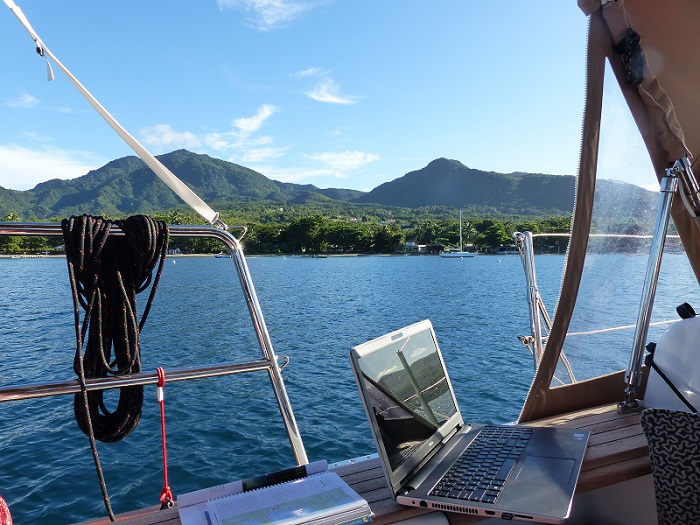 Wow, we are really way down at 15° North latitude with our Tartan 4000 Argon, having sailed her from our homeport of Boston, Massachusetts just a few months ago. The offshore passages to Bermuda and then to Antigua were challenging, and served to further add to our sailing experience.
Wow, we are really way down at 15° North latitude with our Tartan 4000 Argon, having sailed her from our homeport of Boston, Massachusetts just a few months ago. The offshore passages to Bermuda and then to Antigua were challenging, and served to further add to our sailing experience.
Morning in the cockpit of Argon anchored in Prince Rupert Bay, Portsmouth, Dominica ©ArgonSailing.com
When meeting people and talking about how sailing is so central in our lives, most people assume we are lifelong sailors; but we are what I like to call late-in-life sailors having taken our first classes only ten years ago in our early/mid 40s. And what do you know…here we are in the Caribbean after selling our home, cars and most possessions, moving onto our boat, initially in Boston, and now we are on a one-year exploration. Pinch me.
Most mornings now commence in a similar pattern…awake with only the morning sun through the hatch as an alarm, prepare a pot of deep brown coffee with the French press (no electric coffee maker available, of course), relax in the cockpit sipping the dark brew and take in the surroundings before jumping in for a swim and salt water bathing.
Sometimes there is a cooling breeze while the sun remains low in the sky, other times the blanket of heat and humidity is felt immediately having never quite lifted during the night, and at other times there is a passing shower or thunderhead. Ahhhh…exhale. Most mornings but not all… sometimes prohibitive conditions make even preparing coffee impossible (more to come on this below).
Exploring Dominica by Water and Land
Dominica (accent on third syllable), also called Dominique due to her French history or Wai’tu Kubuli (which means “tall is her body”), is considered the most unspoiled island of the Caribbean. (Dominica should not be confused with the much larger country of Dominican Republic, 400 nautical miles to the northwest.)
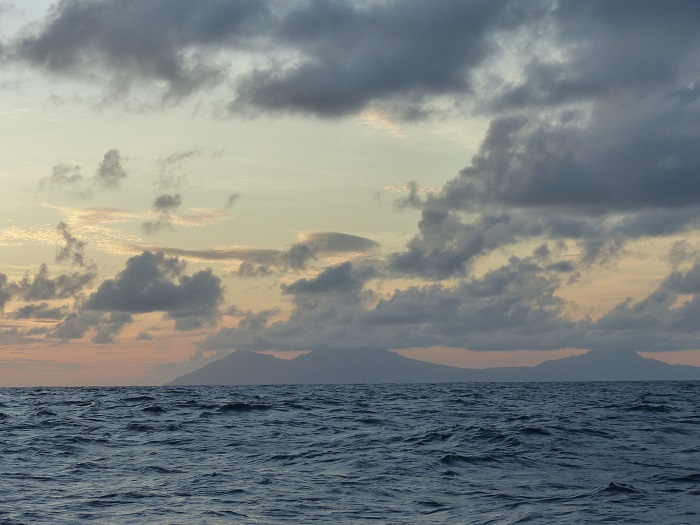
Approaching the rugged and dramatic Dominica at daybreak after a difficult overnight sail. Her mountainous composition forces a ripple in the easterly trade winds. As the warm air is forced up along the mountainsides, the higher altitudes form frequent clouds and brief but intense rainstorms. The regular rainfall and unspoiled landscape give rise to seemingly endless rain forests as well as hundreds of rivers. Dominica has many hot springs and the world’s second largest boiling lake (which is unfortunately currently closed to visitors) as well as many rare bird and plant species. It is a nature lover’s paradise. ©ArgonSailing.com
Our sail to Dominica directly from Antigua consisted of 100nm initially at about 190 degrees then shifting to 160 degrees as we passed Guadeloupe off to port. We decided to tackle this first Caribbean hop rather aggressively by departing Antigua one Friday afternoon in late November, sailing overnight largely in the lee of Guadeloupe, arriving in Prince Rupert Bay, Portsmouth, Dominica at daybreak Saturday.
The initial leg between Antigua and Guadeloupe was choppy, and we were surprised that our normally strong stomachs were not feeling so well. At about 0200 in the dark of night, we were asking ourselves why we ever decided to make our first Caribbean run a long overnighter as we counted down the hours to daybreak. (Most Caribbean sailing consists of 10- to 40-nautical mile hops from harbor to harbor or island to island.) This was a difficult sail for much of the passage and we welcomed the approach to Dominica at first light.
Dominica is the most mountainous of all the islands in the expansive Lesser Antilles range. Much of its nearly 300 square miles is a protected natural park including extensive rainforests and mountains. Dominica has many waterfalls and hot springs, and a whopping 365 rivers! There are few predator species on the island and no large mammals.
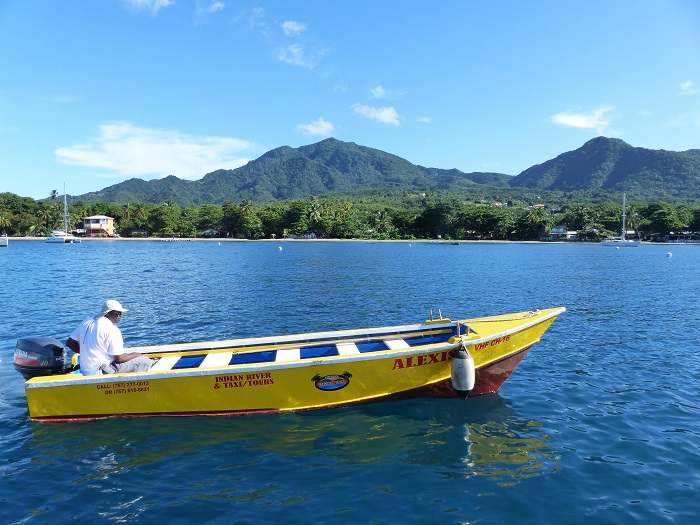
One of the several PAYS boats that provide security, tours and overall great support for visiting cruisers ©ArgonSailing.com
Until fairly recently, Dominica had a surly reputation with cruisers due to crime and pollution throughout the two main harbor cities (Portsmouth in the north and Roseau in the south). Several years ago, however, an organization called PAYS (Portsmouth Association of Yacht Services) was formed to provide security as well as tours, local information, and other services to visiting yachts. Working with one of the many “PAYS certified” Dominicans proved to ensure we had a fantastic stay.
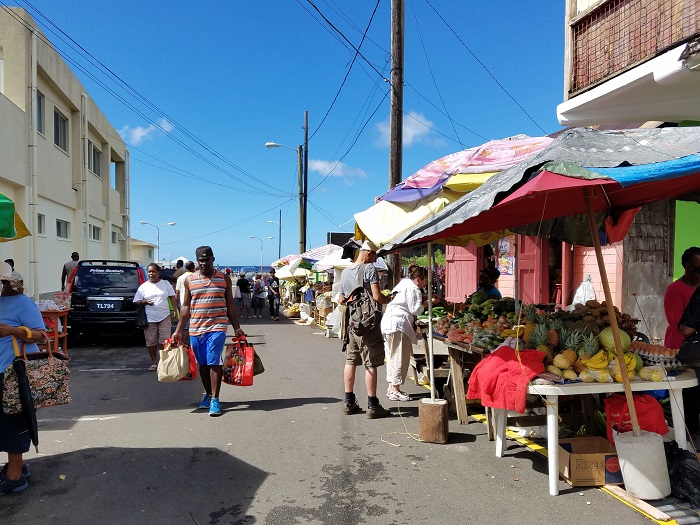
Dominica overflows with coconuts, bananas, passion fruit, mango, avocado, oranges, grapefruit, sugar cane, etc. © ArgonSailing.com
We found Dominica quite intriguing and fantastic on land (not so much on the water…see further below). Portsmouth is the town on Prince Rupert Bay and the second largest city in Dominica, after the capital of Roseau at the southern end of the island. There is a mixture of French and English spoken (the local dialect can be challenging to understand for my naive ears, even when English is being spoken) and the currency is the Eastern Caribbean dollar (about 2.7EC to 1USD). People are extremely friendly and seem to welcome cruisers. The buildings are seemingly haphazard; amenities and commodities are very rudimentary. This is clearly third world, lacking any sign of abundance except for the never-ending fresh fruit.
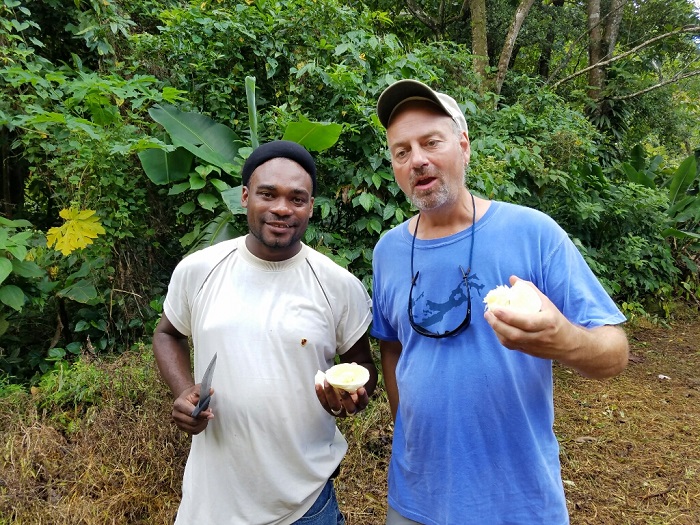
Robert, also from PAYS, took us to explore the Syndicate rainforest and waterfall. Robert was a complete joy to spend the day with, sharing his knowledge and experiences. Dominica has strict requirements for their certified tour guides, who must be very knowledgeable about the island’s history and plant and animal species. © ArgonSailing.com
But All Was Not Well in Paradise…
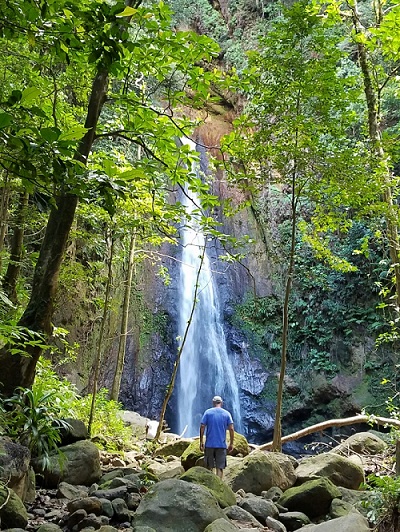 The initially serene anchorage became very uncomfortable as some weather far off to the southwest produced some waves that rolled easily into Prince Rupert Bay. The two and a half mile wide bay opening offers no protection from seas with a westerly component. The relatively constant trade winds had the boats pointing mostly southeast which put these rollers parallel and on our sides, causing some pretty dramatic rolling back side to side.
The initially serene anchorage became very uncomfortable as some weather far off to the southwest produced some waves that rolled easily into Prince Rupert Bay. The two and a half mile wide bay opening offers no protection from seas with a westerly component. The relatively constant trade winds had the boats pointing mostly southeast which put these rollers parallel and on our sides, causing some pretty dramatic rolling back side to side.
In addition to the beauty of the rainforest, it was surprisingly serene. Only two other hikers were passed over several hours as we eventually made our way to a waterfall. © ArgonSailing.com
After a sleepless night and no sign of the conditions easing up, we decided to deploy a stern anchor using our Fortress 23 (which is perhaps one size too big for this purpose but manageable with the dinghy) to keep us somewhat pointing into these waves. The stern anchor helped a bit, however, when a squall would come through with an associated burst of high winds from a different direction, our stern anchor either held us parallel to the rollers not allowing us to swing with the changing winds, or other boats would swing too close to us and we needed to redeploy.
Along with a handful of other boats, we decided to move to the southern part of the large harbor which seemed like it might offer some protection from the rollers, although we would be outside the protection zone of our PAYS friends. At first, we got some relief from the rolling but we continued to experience squalls. In addition, we were unsure if it was safe to leave the boat unattended in this part of the harbor. Later, the rollers started coming in from slightly more north and this part of the harbor no longer provided any protection from them. After two days of these rolling conditions, we reluctantly cut our time in Dominica short, hauled anchor, and set sail for the French islands of Les Saintes, 24nm north, which would offer more protection.
Although we were disappointed to limit our time in Dominica, we would soon be anchoring in an unexpectedly gorgeous and relaxing harbor of Terre-de-Haut, part of the French islands of Les Saintes. Dominica was our southernmost stop on this journey; we now begin leisurely exploration and island hopping northward during the winter months.
Captain Linda Perry Riera and her husband Captain Bob Damiano are the owners and operators of All Hands Sailing Charters, LLC in Boston, MA (allhandssailing.com). You can follow the sailing adventures of Linda and Bob (and view their very well produced videos) at ArgonSailing.com.




